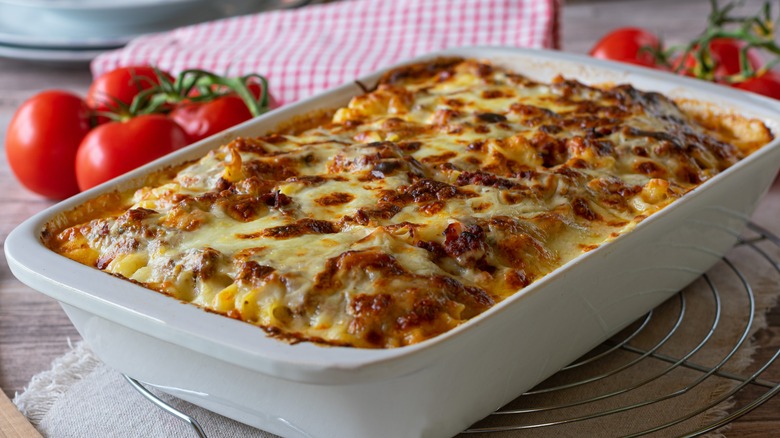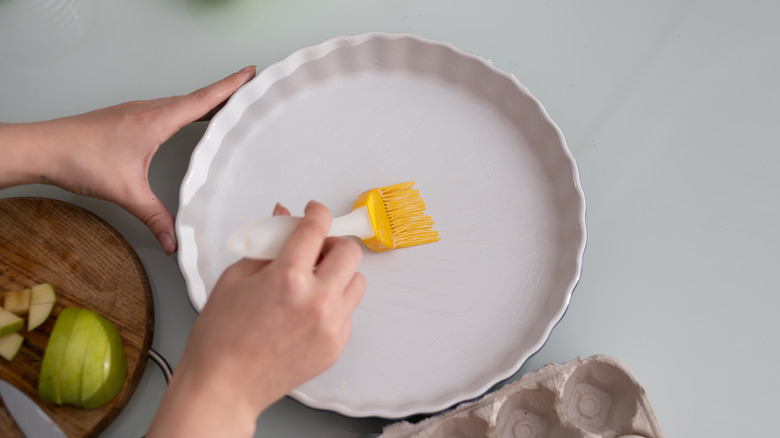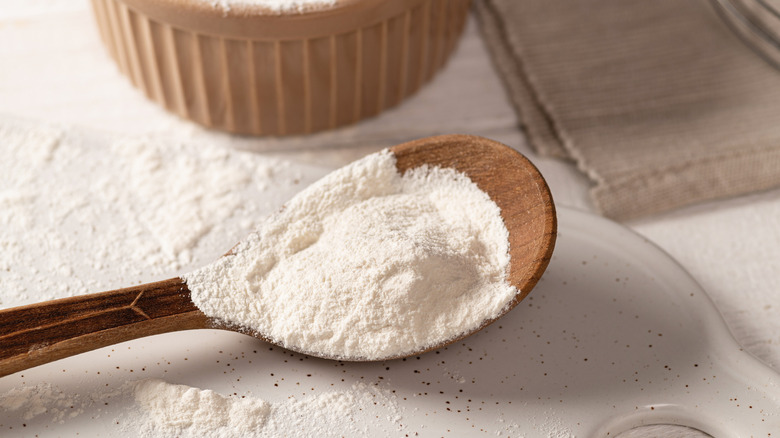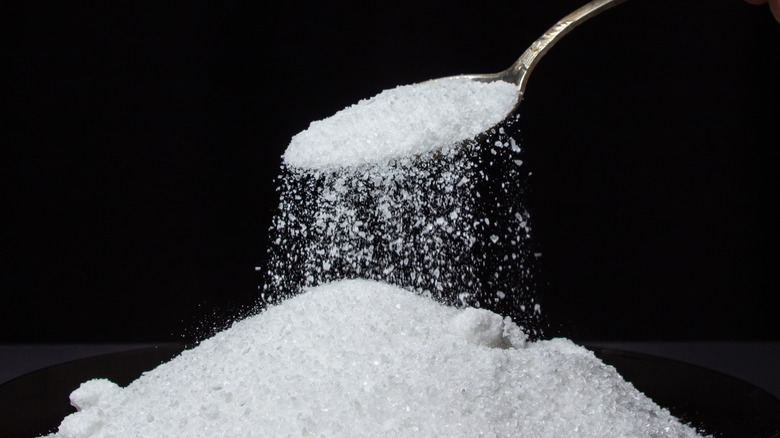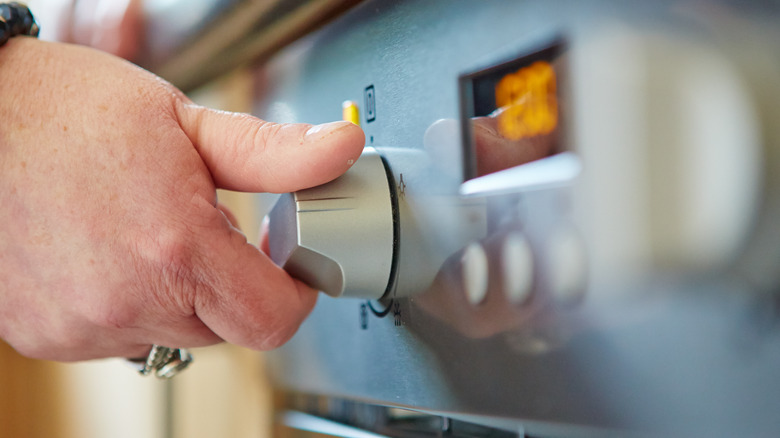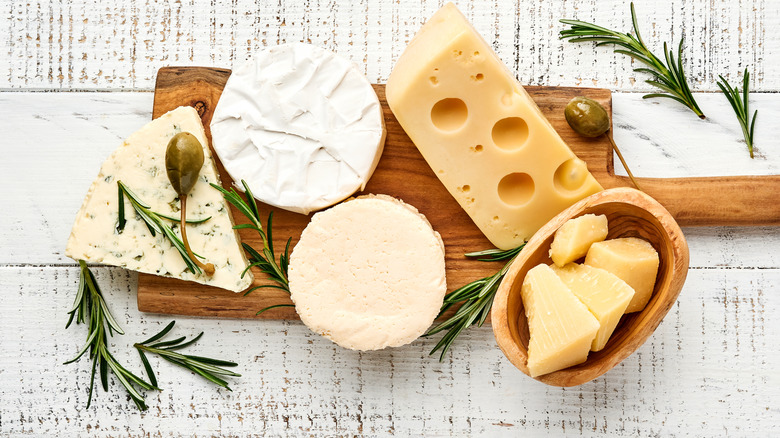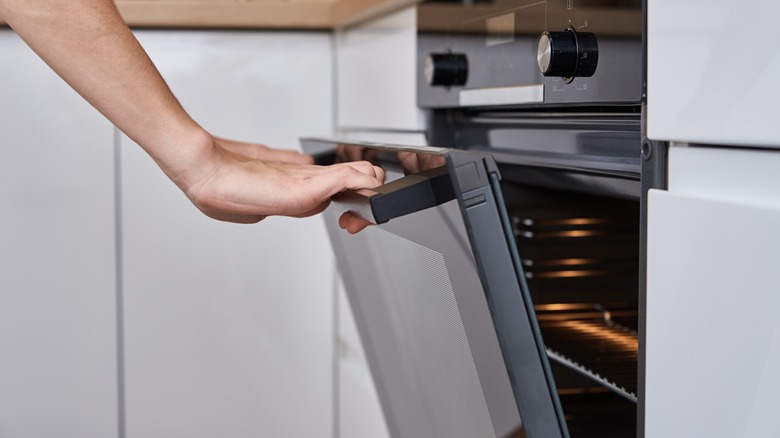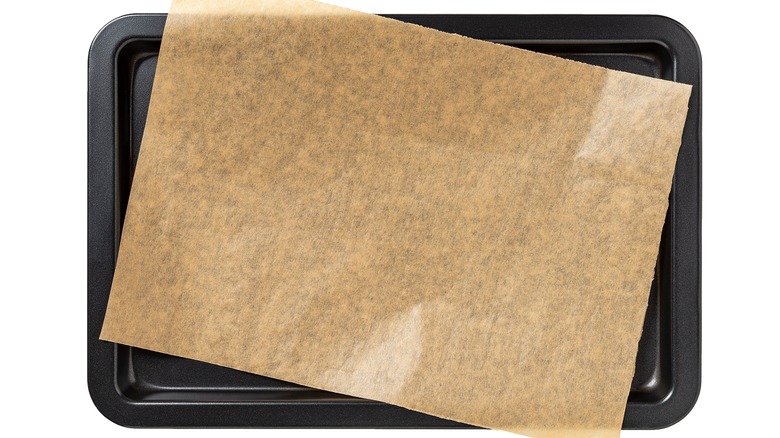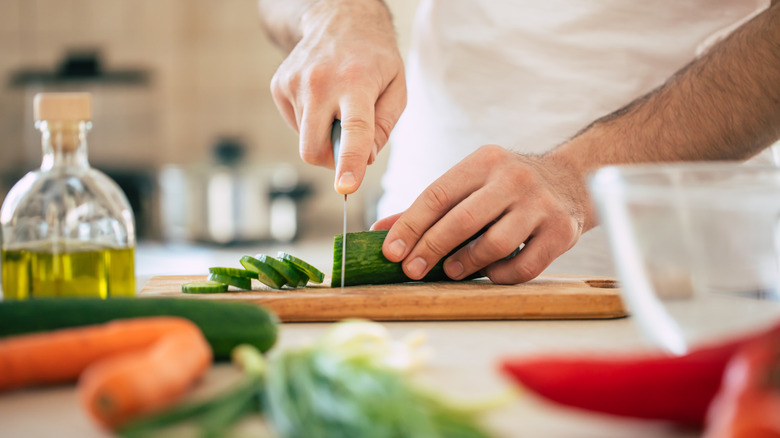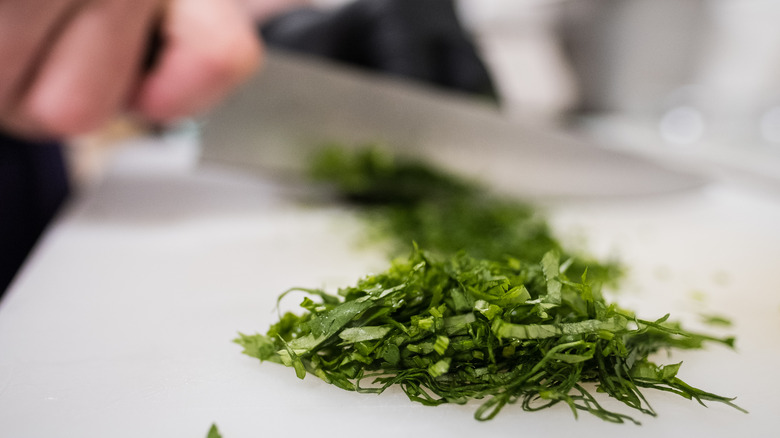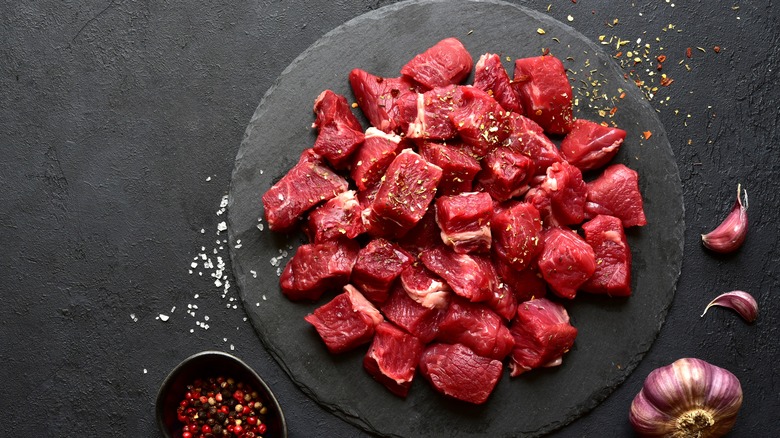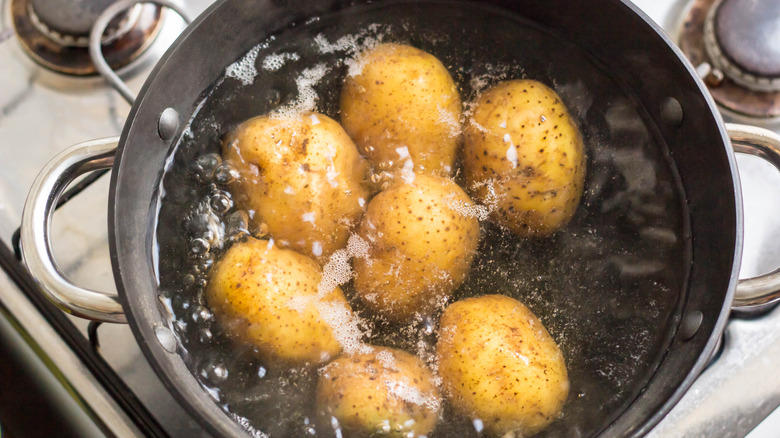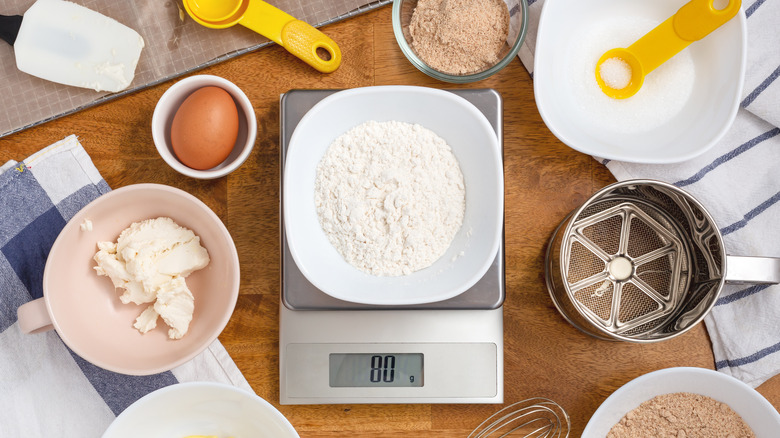12 Mistakes Everyone Makes When Making A Casserole
As a classic comfort food from decades past, the hearty casserole is gradually making a comeback. While this nostalgic food isn't as popular with home chefs as it used to be, spending more time at home during the pandemic has compelled us to give the good ol' casserole another go. Easily the best pantry-friendly and low-maintenance dish you can bake, you get to cook and serve it in the same dish, which means fewer dirty dishes to deal with.
But that's not the only reason you should be preparing this filling dish. Cooking your own homemade casserole means you can limit the sodium and fat content. You can also use more vegetables and turn the dish into a healthy, nutritious meal. However, there is more to a casserole than simply tossing a bunch of ingredients together into a baking dish and sticking it in the oven.
A lot can go wrong when you make a casserole, from mushy textures to too much salt. We'll examine all the mistakes you could possibly make and outline our top tips for avoiding these pitfalls and baking the best casserole every time.
1. Not greasing your baking dish
Casseroles are an absolute favorite. What's not to like about creamy sauce and chunks of meat and vegetables? The dish is bursting with fresh flavors which makes it a fulfilling meal to enjoy. But it's easy to forget one seemingly mundane element that can cost you a near-perfect casserole: Greasing your baking dish. Yup. It's a simple mistake anyone can make, from a rookie home cook to a five-star restaurant chef on a time crunch.
According to Kitchen Seer, you have to grease your casserole dish, especially if you want your food to be presentable. Not only does grease prevent food from sticking to the bottom, but it also allows you to easily — and neatly — remove each slice. Several items commonly found in the kitchen like shortening, ghee, butter, and cooking oil are good candidates. However, keep in mind that each ingredient yields different results. For instance, cooking spray is best for low-fat recipes, whereas butter can transfer its flavor to the food.
Once you've selected your grease, it's time to slap it on your baking dish. Baking Nook suggests applying it to the entire surface, then sprinkling flour over the greased area. Remove the excess flour by flipping the dish before placing a piece of parchment paper if necessary for your recipe.
2. Not adding a thickener
If your casserole dinner is more of a soup, chances are you've skipped the thickener. This essential ingredient firms up your food and improves texture. If it's too watery, your food turns into mush with liquid that has soaked up more flavor than the other ingredients. To compound the effect, any vegetables in your casserole release liquid as the dish cooks in the oven. So to prevent this watery outcome, we recommend using a thickener in your casserole recipe.
According to Oven Via, you can make a slurry using flour and cold water and gradually add it to the casserole while it's cooking. You can also use a cornstarch-water mixture to get the thickness you want. Simply add a tablespoon of cornstarch for every cup of liquid you'd like to thicken. Stir or whisk away any lumps and add the slurry shortly before the casserole is fully cooked.
Meanwhile, a Reddit user offers an excellent suggestion to fix a watery casserole: Dust some flour on the protein so that it combines with extra liquid as it cooks. If you want to skip the flour, use a tablespoon each of cornstarch and milk and add it to the casserole, per a comment on Quora.
3. Adding too much salt
It's all sugar, spice, and everything nice until you make a mistake with salt while cooking. Overdoing it with salt can quickly overpower the other flavors in your casserole. Conversely, using too little can make it bland, so it's best to stick to the recipe measurements instead of winging it. If you have already added too much salt, don't worry as a handful of kitchen remedies can rectify the mistake.
MasterClass lists five ways to neutralize the salt in your food, starting by adding an acidic element like lemon juice or vinegar to counterbalance the salty flavor. However, vinegar can easily clash with other ingredients, so an alternative such as tomato or tomato paste is a good way to tone the salt down. The second way is to add sugar to your casserole. Although sugar is not typically part of the ingredient list, it can be used to tweak salty flavors.
You can also serve the dish with a condiment like sour cream or add dairy products like heavy cream or cheese. Cheddar or Gouda are typically used in casseroles, so you can add a bit more to neutralize the salt. As well, you can add raw potatoes to absorb the excess salt, leaving you with a well-balanced casserole that'll have you begging for another bite.
4. Not preheating your oven
Every baked meal needs adequate time in the oven to bring out the oomph factor. Sometimes, this extra step might be the difference between the world's best casserole and an average-tasting meal. Generally, it's actually a requirement in order to make food that is evenly baked throughout. This means no vegetables or chunks of meat are overcooked, cold, or underdone, and nothing smells burnt.
Per Houston Methodist, preheating your oven ensures that food is cooking at the right temperature. If you don't bring it to temperature ahead of time, chances are that you'll need to leave the dish in for longer than what's stated in the recipe. It's also beneficial to use a food thermometer to check your oven's temperature.
As Bake Club notes, fluctuations in temperature occur in ovens that haven't been preheated, since it takes time for the appliance to reach the desired heat. The oven goes through a cycle of high and low temperatures as it stabilizes to the dial you have set. So the longer you preheat, the more accurate the actual temperature you'll be baking at. If you're not in the mood to eat a soggy undercooked (or burnt) mess, then give your oven a chance to preheat as you prepare your favorite casserole recipe.
5. Not choosing the right cheese
Cheese lovers stand by the belief that every cook should do their duty by putting cheese in everything. But the reality is you can't. No matter how much you might want to, you can't toss just any cheese into a casserole. For starters, you'll want to consider the other ingredients you're putting in the dish and what flavors you're seeking. There are specific cheeses that work best with certain items and the overall profile of the dish.
As Martha Stewart says, cheese brings a salty, fatty, and acidic component to a dish. You can add aged cheese like Parmigiano-Reggiano, Pecorino Romano, cheddar, or Gouda for added complexity. If you're looking for a fresher taste, you can add crème fraîche or a tangy Boursin. If you're into the gooey kind of cheese that will melt in your mouth with the perfect amount of stretchiness, then you're better off picking mozzarella, Jack, Swiss, raclette, and Fontina. If you have other kinds of cheese on hand that stretch just as well, you have our blessing. Moreover, remember that hard cheeses need to be grated, whereas soft and semi-soft styles should be diced before being added to the casserole.
6. Opening the oven door too frequently
Hold your horses, chef; opening your oven door just because you are curious about how the food is doing or simply can't wait until it's finished isn't going to make it cook any faster. If anything, it slows down the cooking process and could even ruin your casserole. According to Andrew Zimmern, the oven temperature can drop up to 50% when you open the door (via Rachel Ray Show). This makes it fundamental to wait until you reach the minimum cooking time stated in the recipe or you might end up having to bake it far longer.
Every time you open the oven door, you're letting the steam buildup escape. Basically, all the heat that was concentrated inside the oven working its magic to give you a perfectly delicious casserole now has a chance to escape. Furthermore, your oven has to work hard to get back to the desired temperature, starting the tedious process all over again.
Martha Stewart notes that your senses can be a great resource to determine whether or not your baked goods or casseroles are done. If your kitchen smells wonderful and the air is pleasantly rich with the aroma of a delicious casserole, then it's almost ready. You can also turn on the oven light to take a peek and use visual cues to estimate how much time is left.
7. Using a metal baking dish
For casseroles, your choices pan out (pun intended) to three baking dishes: metal or aluminum, glass, and ceramic. Of the three, a metal baking dish is the poorest choice. It comes down to the fact that metal is a conductor, which Bake School explains means that it heats up and cools down fast. On the other hand, glass and ceramic pans are good insulators. They tend to heat up slowly and take their sweet time cooling down. Ergo, they are good options for keeping your food warm for a more extended period.
It's hard to beat a plate of hot piping food, especially if it has cheese. Similarly, a casserole is best enjoyed straight out of the oven with steam wafting through the kitchen attracting hungry diners. However, you can't have that outcome if you make your casserole in a metal pan, since the material snatches the opportunity of eating a hot meal. Basically, as the metal pan cools down, so does your delicious casserole. Another benefit of using glass and ceramic pans is that you'll get more browning on the crust since they retain heat and heat more evenly (via Bake School).
8. Not cutting your vegetables uniformly
Beauty is in the eye of the beholder, and we like to see it in the form of uniformly cut vegetables. Aesthetics aside, there's more than one reason to cut your vegetables evenly. According to What's For Dinner, doing so is not only crucial to the success of a dish but also ensures a better taste by allowing them to properly cook. The outlet lists eight techniques for cutting or dicing your vegetables: chiffonade, brunoise, chop, cube, dice, julienne, mince, and slice. Whichever one you choose, uniformly cut vegetables are likely to cook at the same rate.
Vegetables are a great way to add texture to your casserole. However, imagine a carrot chunk in one bite and chewing on a minced piece in the next. This contrast of textures and consistency isn't the kind of clash you want in your dish. The pleasure of eating a delicious casserole is reduced if some bites are overcooked while others are raw and crunchy. So if you're looking to make a finger-lickin' delicious casserole, chop up your veggies the same size. This little bit of effort will go a long way in taking your dish to the next level.
9. Using dry herbs
There's no doubt that adding herbs to a dish infuses it with exquisite flavors. Don't we all know someone with a secret ingredient — always an herb — that everyone wants to discover? Wouldn't we all like to add some herbal magic to our recipes too?
However, knowing how to choose the right kind of herb for a particular dish is as essential as adding it. Rosemary, oregano, basil, parsley, and bay leaves are all options that go well with many casserole recipes. More importantly, Chef Neil Fusco emphasizes the importance of using fresh herbs as much as possible because their flavor often changes when they are dried, ultimately affecting the overall taste of the dish (via Cucina Antica).
If you really want to add a fresh element to your casserole, growing your own herb garden is definitely an option for a true farm-to-table experience. If that's not in the cards, most grocery stores carry a selection of fresh herbs. Once you start using them, you'll see they are a cheap and efficient route to making a dish stand out.
10. Not browning your meat before
Unless you're making a vegetarian menu, meat is the heart of any casserole. An experienced cook knows the little tricks that give a dish that extra kick of flavor. While most people may not think it's essential, searing the meat before incorporating the other ingredients will give your casserole an extra oomph that makes it stand out from the rest.
The most effective way to brown meat without losing its nutritional juices is to sear it at a high temperature. Cooking it on a medium flame results in a greater loss of meat juice, whereas cooking it on a too-high flame will cause the juices to burn, losing all the rich flavors. It is imperative to get that balance just right, in order to improve the taste of the casserole.
If you're cooking big batches of casserole and have a large amount of meat to brown, avoid putting it in the pan all at once. Overcrowding it will make the meat too wet, ultimately beating the purpose of this step. In addition, be sure to re-integrate the juices from the meat that remain in the pan after searing, as they are the root of the overall flavor.
11. Not parboiling your potatoes
Whether you're baking a cheesy potato casserole, loaded baked potato casserole, or any other recipe that uses the very versatile potato, you will have to first parboil them. Perhaps you've skipped this step in the past, unsure of what parboiling really is. Well, it's exactly what the name suggests: to partially boil something. Per Our Everyday Life, parboiling potatoes is an essential step in baking them. Otherwise, it takes an excessive amount of time to reach the desired softness and tenderness that is the mark of a quality-cooked potato.
If you use raw potatoes in your casserole, they will still cook in the oven, but the result will be different than if you'd boiled them first. Since they are already partially cooked when parboiled, the oven simply works to make them soft and moist (or crispy, depending on your recipe). When they're added in raw, the time spent in the oven will only be used to cook them through.
So if you desire a crunchy potato crust, parboiling your spuds is the way to go. You'll see why it's so important when you don't and end up taking a bite of overcooked vegetables and undercooked potato. Plus, parboiling actually speeds up the total cooking time, allowing your potatoes to cook in the same time frame as the other vegetables in your casserole.
12. Not measuring the ingredients properly
Sometimes, we try to act smart by eyeballing measurements without weighing or measuring them correctly and wonder what went wrong when we see the final product. There's nothing more tedious than having to measure out all of your ingredients. However, as per Food Bloggers of Canada, precision in baking is fundamental. It takes a little effort to measure everything, but if you don't get it right, you can wave goodbye to a perfectly cooked casserole.
For instance, if you were to add the wrong quantity of thickener by overdoing the flour to water ratio, you get a pasty texture and the flour will leave behind a weird taste that could ruin the casserole's entire flavor. Not to mention, it will be a sticky mess. Moreover, flour overuse can cause your casserole to be hard and dry, making it inedible. Imagine it all going to waste.
To avoid these outcomes, it's recommended to use graduated dry measuring cups designed to be filled and leveled to the brim when measuring dry ingredients. On the other hand, liquid measuring cups are labeled with volume marks, per Better Homes And Gardens. Getting your ingredients and proportions right is the best way to cook or bake any dish while avoiding a culinary disaster.
